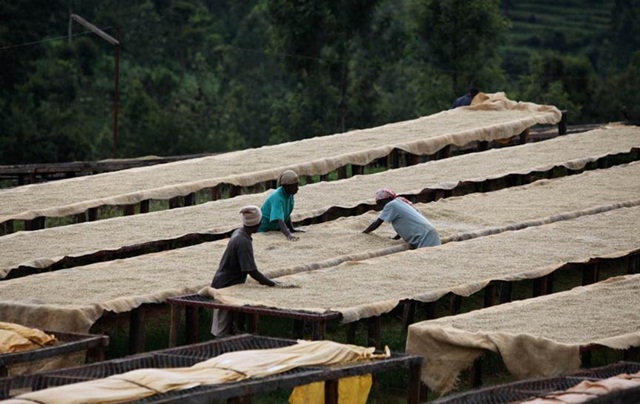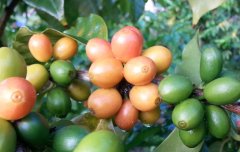Winner of the Mulana Cup Test Competition in Kenya-AA level Champion of Gondor processing Plant in Mulana District

For professional baristas, please follow the coffee workshop (Wechat official account cafe_style)
Today, Green Cafe is going to introduce a super powerful bean! Is the champion of Kenya Mulana Cup Test Competition-Gondor processing Plant from Kenya Mulana District, is the champion batch of AA level!
Why, doesn't that sound very good? Come on, this is not some random vegetable market cup!
Every year, the Mulana producers' Cooperative Union has an internal cup evaluation competition, and a total of more than 40 member cooperatives in the alliance will send samples to participate in the evaluation, not only in the way of the buyer's referee, but also among the cooperatives. the winner enters the quarterfinals and goes through so many rounds of tests before he can win the championship. The most difficult part, Gondor processing field, he has a strong explosive power, even when we taste these top eight cups, we can immediately recognize that he is different, super amazing!
Not good enough?! This champion batch of Kenya Gondor, even the very picky well-known American bean seller Sweet Maria's sold their pearl round beans in 2014; it was so powerful that cup testers could not resist. Then why on earth is this bean so powerful? This should start from its variety, as well as the production environment and treatment plant! Presumably everyone is a stranger to Kenyan coffee, so let Xiao Ka reveal the charming secrets of Kenya one by one.

Kenya, located in East Africa, is one of the important producers of fine coffee in the world, but the overall output is not much, accounting for less than 0.5% of the global production. There are two seasons in Kenya, the main time is from October to December each year, and the other season with less yield is from April to June. Kenya has complex topography, including plateaus, deserts, canyons and grasslands, and the main coffee producing areas are spread around the mountains of Kenya (MT. KENYA, volcano) and Elgang Mountain (MT. Elgon), between 1000 and 2500 meters above sea level, such as the Kenyan Mountains in central China, there are Aberdare Zone, Nyeri, EMBU and MERU, which are all very important producing areas in Kenya.

The main variety of production in Kenya is Arabica, but unlike Arabica in other countries, the main ones are SL28, SL34, K7, Ruilu 11 (Ruiru), Batian and so on. SL28, SL34 and other classic varieties of Kenyan coffee, these varieties themselves have a strong and unique sour aroma, many people are deeply fascinated by the flavor of Kenya! However, a difficult problem faced by international high-quality raw bean buyers in recent years is that the classic Kenyan flavor is becoming more and more difficult to find, mainly because of land development, the planting area of coffee farmland in Kenya is shrinking, and the output is therefore decreasing. Coupled with the local implementation of Kenya Coffee production of new varieties such as Ruiru or Batian, so that the classic SL28, SL34 flavor is also gradually reduced, even many well-known processing plants can not escape this trend.

The Kenya to be recommended this time comes from the Gondor processing Plant (Gondo) in Murang'a, which used to be part of the New Kirit Co-operative, but now belongs to the larger Mulana producers' Cooperative Union (Murang'a Farmers Co-op Union Ltd.), which has more than 40 affiliated cooperatives / processing plants. The Mulana producers' Cooperative Union holds an internal cup competition every year, and more than 40 member cooperatives in the union send samples to participate in the evaluation (as mentioned at the beginning, Gondor won the championship in one fell swoop).
This batch is selected by our coffee partners directly into the producing areas, purchased at a price higher than the average price for farmers, and introduced to you with the advantage of direct trade. A classic Kenyan SL28, SL28 has a mixed pedigree of French missionaries, mochas and Yemens Tibica. Although the yield of SL28 is not as expected when it was cultivated, the copper leaf color and broad bean-shaped beans have great sweetness, balance and complex flavor, as well as remarkable citrus and black plum characteristics. (when the editor drinks Gondor this bean, he feels sweet like black plum juice.)

In this championship batch, we set it to be baked in medium and shallow. The entrance is like drinking bright grapefruit juice, excluding the acidity of grapefruit, it is as sweet as honey, and the sweet and solid taste is overturned in the whole mouth. Stacked in the middle is blackcurrant, BlackBerry juice, sweet and sour taste, slightly lower temperature and then transformed into a throat incomparable black plum juice, powerful. Layers of taste and flavor challenge the sensory limits of you and me!
Important Notice :
前街咖啡 FrontStreet Coffee has moved to new addredd:
FrontStreet Coffee Address: 315,Donghua East Road,GuangZhou
Tel:020 38364473
- Prev

An introduction to the Origin and Development of Rosa Coffee
The species of Geisha was discovered in the Rose Summer Forest of Ethiopia in 1931 and sent to the Coffee Institute in Kenya; it was introduced to Uganda and Tanzania in 1936, in Costa Rica in 1953, and Panama was introduced in the 1970s by Francesca of Dongba Seven Farm Garden. Mr. Serraxin got the seeds from CATIE, Costa Rica, and started growing Rosa Coffee.
- Next

Rwanda Fine Coffee Grade Cup Flavor testing American Aid Program USAID
The taste of Rwandan coffee is described as a grassy aroma with tropical climate characteristics. The country's fertile soil and climate help plants grow, and coffee trees seem to be driven or forced upward, or because they grow too fast to produce the best coffee beans. But in any case, the soft and full-bodied taste of the country's coffee is great. On the package
Related
- Detailed explanation of Jadeite planting Land in Panamanian Jadeite Manor introduction to the grading system of Jadeite competitive bidding, Red bid, Green bid and Rose Summer
- Story of Coffee planting in Brenka region of Costa Rica Stonehenge Manor anaerobic heavy honey treatment of flavor mouth
- What's on the barrel of Blue Mountain Coffee beans?
- Can American coffee also pull flowers? How to use hot American style to pull out a good-looking pattern?
- Can you make a cold extract with coffee beans? What is the right proportion for cold-extracted coffee formula?
- Indonesian PWN Gold Mandrine Coffee Origin Features Flavor How to Chong? Mandolin coffee is American.
- A brief introduction to the flavor characteristics of Brazilian yellow bourbon coffee beans
- What is the effect of different water quality on the flavor of cold-extracted coffee? What kind of water is best for brewing coffee?
- Why do you think of Rose Summer whenever you mention Panamanian coffee?
- Introduction to the characteristics of authentic blue mountain coffee bean producing areas? What is the CIB Coffee Authority in Jamaica?

